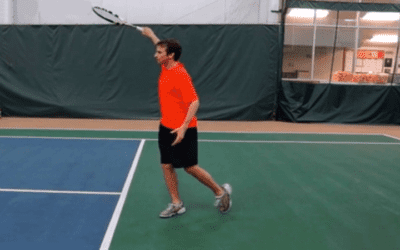Tennis Serve: Kick Serve vs. Flat Serve Pronation

One of the most misunderstood concepts among tennis players and coaches at all levels is pronation on the tennis serve.
I’ve often get asked, should I focus on pronation on my flatter first serve and on my kick serve?
Well, that’s an excellent question and I’ll break it down for you today.
I’m going to explain the difference in pronation between the flat serve and kick serve. Therefore, you can understand how pronation actually works and what you should focus on.
I’m sure that after you finish reading this article, you’ll probably look at pronation in a different way.
If you master pronation on the tennis serve, you’ll be able to hit a kick serve easily and transform your tennis game.
Let’s get started.
Flat Serve Pronation

I had excessive pronation on my flat serve because I had great technique. Hence, I was able to develop one of the best serves on the pro tour. On the flat serve, you’ll pronate more as you’ll have your arm going out more towards the target. In fact, the strings will be facing away from you at the end of your swing. This will come from the shoulder rotating at the right moment.
Kick Serve Pronation

Now, let me explain pronation on the kick serve. First, you’ll not have as much pronation on this type of serve as you do in your flat serve. The strings will face in a different direction at the finish. Your arm will bend more and stay to the side of the body with the strings facing towards the back fence at the point of pronation.
If you have a great stance, first move, toss, trophy position, racquet drop, and swing path, pronation just happens naturally. You’ll not need to think about it as you hit your tennis serve. This is a concept that I often emphasize to my students. I don’t think that you need to focus on pronation. Instead, I recommend to focus on building solid fundamentals on all the core elements of the tennis serve mentioned above.
Serve Pronation Tips

To master pronation on your tennis serve, I suggest to focus on the following aspects. First, get the toss in the right place. Then, ensure that your serve technique is solid by having the proper finish and relaxing the hand at the end. When you follow these basic steps, you’ll be able to pronate properly on both flat and kick serves.
Finally, I’ll give you a powerful bonus tip. Make sure to work on shoulder strengthening exercises with a resistance band at least twice per week. Hence, you decelerate the racquet correctly on your tennis serve and reduce the chances of getting injured.
I hope you enjoyed today’s article on pronation and the comparison between the flatter first serve and the kick serve. I’m committed and passionate about helping tennis players worldwide to develop their serves into a weapon. As a result, they can have more fun on the court and win more tennis matches.
By Jeff Salzenstein, Founder Tennis Evolution
Jeff is a former top 100 ATP player and USTA high-performance coach committed to helping players and coaches all over the world improve.
P.S. – Ready to take it to the next level with your tennis? Click here to get a free membership (no credit card required which includes 21 lessons covering all aspects of your tennis ($567 value). Learn the exact step-by-step system that has transformed the games of thousands of players worldwide.
7 Comments
Submit a Comment
You must be logged in to post a comment.



Jeff,
Not tennis related question. I see you have a degree in economics from Stanford. are you invested in the bitcoin craze!!?
Hi Jeff!
I am a customer of yours from Sweden and you do a great job! About pronation it’s important to note that we Europeans don’t learn to throw a ball at an early age like Americans do. We don’t play baseball here and that’s probably why we don’t have as many great servers as you do. Of course there are natural throwers but to me learning to pronate was a great mystery and took many years to make natural. In the beginning I didn’t have any instinct at all to pronate before hitting the ball but could have continued on edge forever. Now I am wrestling with another challenge, namely the importance of loading the hip and then to relax the arm at the same time I rotate the hip backwards. A lot of the power and the wrist snap is contained there but I don’t think I have ever seen a video pointing that out. To load the hip yes but not how loading and unloading the hip promotes the accelleration of the racket and the weight shift to the front foot. Roddick quit because he couldn’t accellerate his hips after his hip surgery.
Best to you!
Solo
Thank you for your thoughtful response and share, Solo. I really appreciate it.
Well done Jeff,
One of the best instructional videos on the kick serve with some added finer elements that I will be trying out to improve my own kick serve. I watch all the videos I can of yours and you have helped me make real gains in my 4.0+ game. Thanks again for the top notch professional help you share with all of us recreational players.
Dan
Dan, Thank you for your thoughtful words. I really appreciate it.
Jeff,
I like your instruction and follow it and have learned a lot from you, but I’m sorry to have to say you’re wrong about this one! The pronation is identical in the two serves, as proven beyond doubt or question by your video.
The difference between the two frames is in the direction your serving arm points, not in the amount of pronation. In the kick-serve frame, your serving arm points almost directly toward the camera, therefore the face of the racket is toward the back fence. In the flat serve frame, your arm is extended toward the net, therefore the face of the racket is toward the side fence.
But in both frames, your hitting arm is parallel to the court surface and the racket is pointed straight down, vertical, perpendicular to the court surface. When your arm is parallel to the surface of the court, the only way to make the racket point straight down toward the court is to pronate. There is no other way to do that.
It makes no difference whether your arm is pointing toward the net or toward the side fence. In both cases you have to pronate in order to get the racket pointed at the ground.
You can try this in your living room. If you hold your arm out parallel to the ground, the only way to make the racket point toward the ground is by pronating. There is no other biologically possible way to do that.
So I think you need to revise your commentary to the two videos. It’s the direction of the swing path that is different between the two serves, not the amount of pronation.
Bob
On most tennis websites there is no explanation of what pronation (or supination) actually is – rotation of the lower forearm. The wrist has no choice but to go along with this.
The movements of the wrist independently of the forearm are adduction, abduction, flexion and extension. Some or all of which also occur in different kinds of tennis serves.
If you compare the two serves in this video, there is a big difference in the amount of pronation. In the flat serve there is full 180 degree pronation. In the kick serve there is only 90 degree pronation with wrist flexion used to get the racket pointing down.
Philip